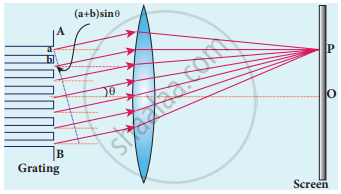Advertisements
Advertisements
Question
Discuss the diffraction at a grating and obtain the condition for the mth maximum.
Solution
- Grating has multiple slits with equal widths of size comparable to the wavelength of diffracting light.
- Grating is a plane sheet of transparent material on which opaque rulings are made with a fine diamond pointer.
- The rulings act as obstacles having a definite width b and the transparent space between the rulings act as slit of width a.
- The combined width of a ruling and a slit is called grating element (e = a + b). Points on successive slits separated by a distance equal to the grating element are called corresponding points.
 Diffraction grating experiment
Diffraction grating experiment - Let a plane wavefront of monochromatic light with wave length λ be incident normally on the grating.
- As the slits size is comparable to that of wavelength, the incident light diffracts at the grating.
- A diffraction pattern is obtained on the screen when the diffracted waves are focused on a screen using a convex lens.
- The path difference δ between the diffracted waves from one pair of corresponding points is,
δ = (a + b) sin θ
This path difference is the same for any pair of corresponding points. The point P will be bright, when
δ = mλ where m = 0,1,2,3
Combining the above two equations, we get,
(a + b) sin θ = mλ
Here, m is called an order of diffraction.
- Condition for zero order maximum, m = 0
For (a + b) sinθ = 0, the position, θ = 0. sin θ = 0 and m = 0. This is called zero order diffraction or central maximum. - Condition for first-order maximum, m = 1
If (a + b) sin θ1 = λ, the diffracted light meet at an angle θ1 to the incident direction and the first-order maximum is obtained. - Condition for second-order maximum, m = 2
Similarly, (a + b) sin θ2 = 2λ forms the second-order maximum at the angular position θ2.
Condition for higher-order maximum
On either side of central maxima, different higher orders of diffraction maxima are formed at different angular positions.
If we take,
N = `1/("a + b")`
`1/"N"` sin θ = mλ (or) sin θ = Nmλ
- Condition for zero order maximum, m = 0
APPEARS IN
RELATED QUESTIONS
Two coherent monochromatic light beams of intensities I and 4I are superposed. The maximum and minimum possible intensities in the resulting beam are ______.
First diffraction minimum due to a single slit of width 1.0 × 10-5 cm is at 30°. Then wavelength of light used is ______.
What is diffraction?
Differentiate between Fresnel and Fraunhofer diffraction.
Mention the differences between interference and diffraction.
Discuss the special cases on first minimum in Fraunhofer diffraction.
What is Fresnel’s distance? Obtain the equation for Fresnel’s distance.
What is resolution?
Discuss diffraction at single slit and obtain the condition for nth minimum.
Discuss the experiment to determine the wavelength of monochromatic light using a diffraction grating.
Discuss the experiment to determine the wavelength of different colours using diffraction grating.
What is the difference between resolution and magnification?
Light of wavelength of 5000 Å produces diffraction pattern of the single slit of width 2.5 μm. What is the maximum order of diffraction possible?
Consider sunlight incident on a pinhole of width 103A. The image of the pinhole seen on a screen shall be ______.
- a sharp white ring.
- different from a geometrical image.
- a diffused central spot, white in colour.
- diffused coloured region around a sharp central white spot.
